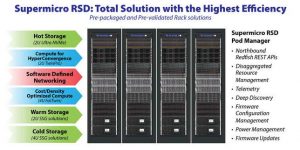Rack Scale Design 2.1 With Pooled All-Flash NVMe Composable Storage Support From Supermicro
Advanced Peta-scale NVMe pooled storage shared by up to 12 hosts and dynamically managed from OpenStack for flexible high-performance cloud infrastructure
This is a Press Release edited by StorageNewsletter.com on April 20, 2018 at 2:21 pmSuper Micro Computer, Inc. announced the release of Rack Scale Design (RSD) 2.1 with pooled all-flash NVMe composable storage support for applications like high throughput ingest, HPC, data analytics, video streaming, CDN, and software-defined storage (SDS) environments.
The RSD empowers cloud service providers, telecoms and Fortune 500 companies to build their own agile, efficient software-defined datacenters or expand existing ones. It is based on Intel Rack Scale Design (Intel RSD), which is an industry-aligned datacenter architecture built on open standards. Intel RSD helps large datacenters support new data-centric applications that require large amounts of fast storage to be shared while enabling increased speed, agility and automation. In an environment of datacenter growth, Intel RSD provides an infrastructure blueprint with more flexibility and scalability, higher security and better control, while delivering substantial savings in CAPEX and OPEX.
The firm’s RSD manages racks of disaggregated servers, storage, and networking with industry standard Redfish Restful APIs that remain consistent across different vendors and multiple server generations. RSD 2.1, supports high performance, high density, and disaggregated NVMe storage for improved datacenter efficiency, increased utilization and lower costs. Based on Intel RSD version 2.1 spec, the arrival of this technology marks the beginning of a paradigm shift to deploy disaggregated resource pools in large-scale data centers that improve datacenter efficiency, increase utilization and reduce costs.
“Occupying just 1U of rack space, our all-flash NVMe storage systems support 32 hot-swap 2.5″ NVMe SSDs for a half petabyte of high-performance storage wth Supermicro RSD 2.1 that can be shared by 12 hosts simultaneously,” said Charles Liang, president and CEO, Supermicro. “With dynamically composable server nodes, efficient storage utilization, and independently upgradeable compute resources, our RSD 2.1 solutions with advanced NVMe pooled storage are perfect for efficient and flexible hyperscale datacenters. In fact, we have already deployed these 32-drive systems running Hadoop workloads for a major automobile company.“
For optimal compatibility, the RSD 2.1 runs on all X11-generation server and storage systems supporting Xeon Scalable processors as well as Supermicro X10-generation server and storage systems supporting the Intel Xeon processor E5-2600 v4 family. This cross-generational hardware compatibility offers customers investment protection and the flexibility to either build new or expand their existing datacenters. In addition, it is integrated with other datacenter management software layers such as OpenStack using the Restful Pod Manager APIs that enable end-to-end cloud infrastructure deployment.
The traditional way of scaling up datacenter resources often involves adding server nodes with fixed computing, networking, and storage ratios. Due to the different life cycles of these resources, a wholesale upgrade of the entire set of server nodes will often lead to premature retirement of valuable investments and resource underutilization. That is why Supermicro’s resource-saving, disaggregated NVMe storage solutions like NVMe-oF (NVMe over Fabric) are important to customers who want to build more efficient and flexible hyper-scale datacenters.
Other key features in RSD 2.1 include:
-
An interactive dashboard that provides the datacenter administrators an overview of all physical assets under RSD management
-
An interactive, topological view of the physical rack and chassis in the Supermicro Pod Manager UI. Administrators can further select chassis in the rack to drill down on details at the component level such as BMC IP address, physical position in the rack and related capabilities.
-
Analytics and telemetry about system overview, utilization, CPU, memory and composed nodes. The historical data will not only help users understand how their systems were used but also predict possible future system behaviors.
Customers can evaluate the flexibility, performance, efficiency and manageability of the company’s RSD 2.1 systems today in the RSD Solution Centers. Each center supports both on-site visits and remote access, allowing customers to dynamically configure hardware resources for specific workloads using the RSD GUI or command-line interface (CLI).
Video: Supermicro RSD 2.1 resource















 Subscribe to our free daily newsletter
Subscribe to our free daily newsletter

